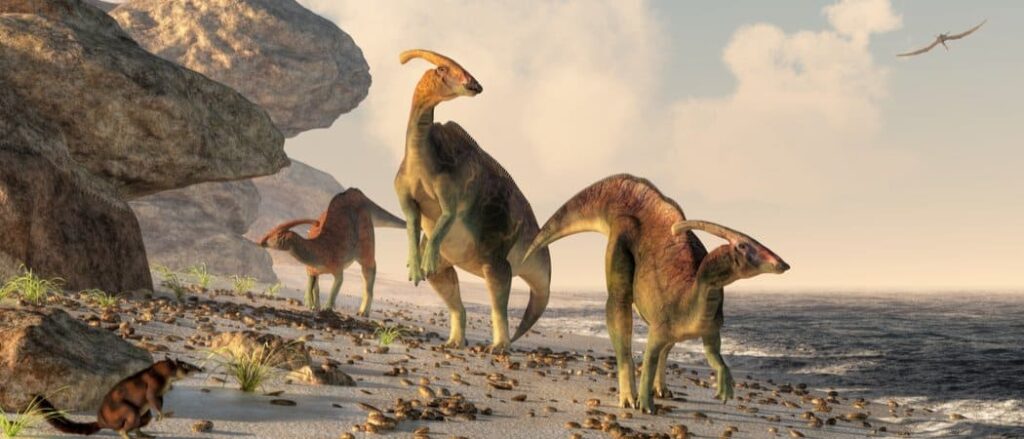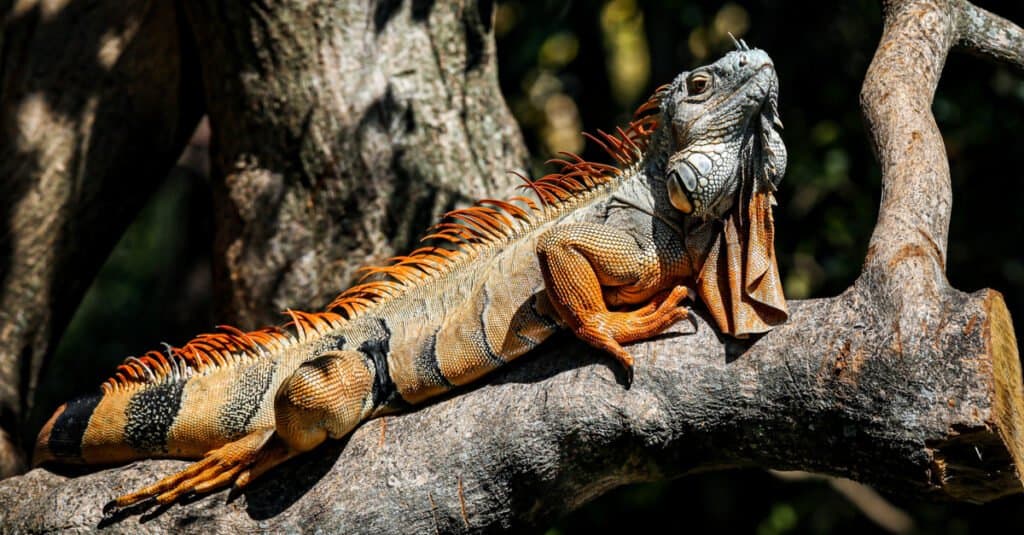
Quick Answer:
- Yes, most dinosaurs are classified as reptiles. However, not all reptiles are dinosaurs.
- There were large birds that fit more into the avian category that are also considered dinosaurs.
- Dinosaurs are (mostly) prehistoric animals who have lived across different geologic time periods.
- Dinosaurs tend to stand upright, lay eggs, and most have lived on land.
- Reptiles are always vertebrates and cold-blooded. They usually do not have fur or hair and most give birth by laying eggs.
As you may know, history appears to consistently portray the dinosaur as a form of reptile. Most media seems to agree, as does a lot of science. But were they? Are dinosaurs reptiles?
The answer is yes, most dinosaurs are classified as reptiles.
However, there were large birds that fit more into the avian category which are still considered dinosaurs.
Dinosaurs were once masters of the universe. The animals, a diverse group of creatures, ran the earth over 200 million years ago, long before humankind came along. They’re classified as both avian and non-avian. Avian dinos flew the skies, making them very distant relations to birds.
Scientific research concludes that a meteor strike wiped out every species of dinosaur 65 million years ago.
It was initially believed the animals were sluggish and cold-blooded, simply because of their size and density. This is what encouraged people to determine that dinosaurs are reptiles. But updated research in the 1970s implied the dino was quite active and quite likely warm-blooded. The animals were socially interactive and had elevated metabolisms.
As recently as 2018, researchers discovered that some dinosaur species had fur and feathers, which was revelatory. The theory dismissed a long-standing belief that all dinosaurs were bare-skinned or scaly.

Paleontologists — scientists that study life forms in previous geologic periods — recognize well over 1,000 non-avian species of dinosaurs, and they aren’t all the giants we imagine them to be. There were tiny, feathery insects who hunted, and giants that weighed tons and grew to be 100 feet in length. There was also a multitude of prehistoric animals of all shapes and sizes that fell in between. They all belong to the family of dinosaurs.
Dinosaurs had unique appearances: horned, armored, dome-headed, crested, long-necked, sickle-clawed. They were both peaceful vegetarians as well flesh-ripping predators. Dinosaurs were quiet and loud. They were terrestrial and amphibious. Scientists even uncovered a swimmer, not unlike a velociraptor, that moved with swan-like grace.
Scientists have determined that dinosaurs have lived all over the planet, on all seven continents. The major land masses of Earth were once joined together as the super continent known as Pangea. Dinosaurs experienced the gradual breaking apart of this giant land form during the first 165 million years of their existence, which spread them throughout the globe as they evolved.
Science theorizes the flying dinosaur is the only animal to survive extinction. The thinking is that the last dinos evolved into the birds we’re so comfortable with today!
Humans share similar body plans based on four limbs. Arms and legs, although our skeletons are very different, we have many of the same type of bones. An example of this would be the bones in our arms and hands. This can go back to our swamp-dwelling ancestors almost 400 million years ago.
Alternatively, here are some of the dinosaurs’ most common traits — some link them to reptiles, and some do not.
- An upright stance, with legs perpendicular to the body, is the main feature that sets dinosaurs apart from most reptiles.
- The dino laid eggs, as do most reptiles.
- Dinosaurs lived on land rather than in the seas. The exception was a few birds like penguins.
- Archosaurs have a hole in the skull that rests between the nostril and eye socket.
- There are two holes behind a dinosaur’s eye socket. Strong jaw muscles passed through the holes and attached directly to the skull. That allowed the jaws to open wide and clamp with extreme force.

Reptiles are cold-blooded vertebrates. No recorded species of reptiles have feathers or hair, just scales. While there are species that give birth to live young, most, like the dinosaur, lay eggs.
Reptiles may likely have been part of the dinosaur world. The earliest discovered reptilians living alongside the dinosaur go back 300 million years.
Reptiles make up a massive family of creatures. Members of the reptile family include crocodiles, alligators, snakes, turtles, and lizards. There is also genetic evidence that shows birds — descendants of avian dinosaurs — are closer relatives of crocodiles, more so than the crocodile is a relative of snakes, lizards, or turtles.
Reptiles have made their homes on every continent in the world, except Antarctica. They have evolved to be able to live in the ocean, jungle, desert, and everywhere in between!
All species of reptiles are covered in scales, have at least one lung, and typically have four legs. (Most people mistakenly believe all dinos have scales, but this is not true.)
Reptiles are broken into four groups: turtles, crocodilians (alligators and crocodiles), Squamata (snakes and lizards), and tuatara (lizard-like creatures endemic to New Zealand).

Dinosaurs and reptiles shared the land and the seas at one time. Birds are predecessors of the avian dinosaur. Similarities include an S-shaped neck and three toes on the feet.
The dinosaur and reptile can be mistaken as belonging to the same species, and most media seems to give them strong physical resemblances, but there are significant differences between the creatures.
Reptile legs extend to the sides of their bodies, with the thigh bones nearly parallel to the ground. They move in side-to-side motions. Dinosaurs stand with their legs directly under them, like most animals, including humans. The positioning of the hip socket allows dinosaurs to stand upright. This posture lets dinosaurs move faster than reptiles and with more endurance.
Now, to dig further into the discrepancies, you need to view it from an evolutionary angle. You can separate non-dinosaurs and dinosaurs with slight details, such as the dinosaur’s hind limbs or facts like the triceratops has more in common with a pigeon than a reptile.
In other words, all dinosaurs are not birds but all birds are, in fact, dinosaurs. The bird is essentially the only dinosaur roaming the earth today.
The term “dinosaur” is typically seen as a name for a large, ancient group of creatures that no longer exist, and implies that all dinosaurs belong to the same family. “Dinosaur” is actually a term the scientific community uses to define members of a long-extinct prehistoric animal group of animals.
Pop culture convinces us that dinosaurs and non-dinosaurs are intermingled, but public opinion does not take into accurate account that dinosaurs weren’t a single species. It also isn’t suitable to see them all as reptilian.
There are ways to tell if what you see on television is an actual dinosaur. Features that unite these animals revolve around the high and thigh structures. It’s what gives these beasts that pillar-legged, upright stance. Check out the upper thigh bone to see if the region turns inward to fit into the hip socket during movement.
Another challenge in distinguishing dinosaurs is that pedestrian thinking leans on the idea that the past happened all at once. This idea causes us to blur the past as we get farther away from it. Concepts such as the evolving dinosaurs living millions of years apart are not really a part of common dino knowledge.
We don’t imagine these animals as varying and evolving over millions of years. There’s the sail-backed Dimetrodon, a protomammal closer to man than a dinosaur. The ichthyosaurs swam in the seas. During the Mesozoic period, many lineages of reptiles adapted to water life. The popular pterosaurs in the Jurassic Park movies were only cousins of dinosaurs, but they were not actually dinosaurs.
General history sees the ancestry of these ancient creatures as a single-family. The truth is, like any species, each member of the dino clan is unique.

According to the Natural History Museum, large numbers of dinosaurs that ran the earth for close to 160 million years are reptiles.
Like man, they developed the ability to survive in many ecosystems. It’s said an influence of the animals’ survival was their straight hind legs, which ran perpendicular to their torsos. They were able to move faster and with less energy than other reptiles.
Dinos are archosaurs, a large group of reptiles that trace back over 250 million years ago. Non-dinosaur reptiles include archosaurs.
There are many species of reptiles wrongly called dinosaurs. Marine reptiles like the plesiosaurs, ichthyosaurs, and mosasaurs do not belong to the dinosaur family, nor do members of the Dimetrodon family.
What separated most of these animals was they didn’t share the dinosaur’s upright posture.
So, dinosaurs are reptiles and, fascinatingly, birds are dinosaurs. This would mean, in one way or another, all are unique but related to reptiles.